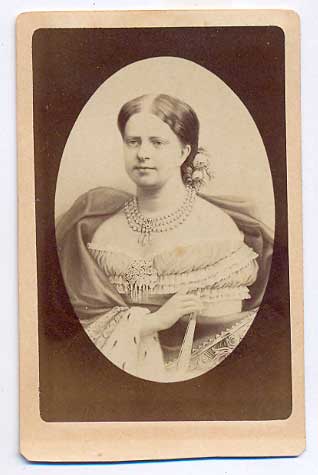by Emily McMahon © Unofficial Royalty 2013

Photo Credit – Wikipedia
Born on March 2, 1843, at the Royal Palace of Turin in Savoy, now part of Italy, Ludovica Teresa Maria Clotilde was the eldest of the eight children of Vittorio Emanuele II, Duke of Savoy, the future first King of Italy, and Archduchess Adelheid of Austria. The princess was known from birth by her last two names, Maria Clotilde.
Maria Clotilde had seven younger siblings:
- King Umberto I of Italy (1844 – 1900) – married Princess Margherita of Savoy, had issue
- Prince Amedeo, Duke of Aosta (1845 – 1890) – later King Amadeo I of Spain – married (1) Maria Vittoria dal Pozzo, had issue; (2) Princess Maria Letizia Bonaparte, had issue
- Prince Oddone, Duke of Montferrat (1846 – 1866) – unmarried
- Princess Maria Pia (1847 – 1911) – married King Luís I of Portugal, had issue
- Prince Carlo Alberto, Duke of Chablais (1851 – 1854) – died as a child
- Prince Vittorio Emanuele (born and died 1852) – died at birth
- Prince Vittorio Emanuele, Count of Geneva (born and died 1855) – died as an infant

Maria Clotilde’s parents and siblings; Credit – Wikipedia
Just days after giving birth to her last child, Maria Clotilde’s mother Adelheid fell ill after attending the funeral of her mother-in-law. Adelheid herself died four days later, on January 20, 1855, leaving 11-year-old Maria Clotilde, the eldest of her six surviving children.
Despite her early death, Adelheid’s actions and character had a great deal of influence on her eldest daughter. Dutiful and deeply religious, Maria Clotilde tried to serve as a second mother to her brothers and sister. Vittorio Emanuele became King of Sardinia in 1849, a few weeks after his eldest daughter’s sixth birthday. He had only occasional contact with his children in the years that followed due to his work toward the unification of Italy and the attention he paid to his numerous mistresses.
Vittorio Emanuele was eager to gain the support of the United Kingdom and France against Austria during the Wars of Italian Independence. To seal a French-Italian alliance, a marriage between Maria Clotilde and a Bonaparte prince was arranged in 1858. Emperor Napoleon III’s only son was a toddler at the time so his cousin Napoléon-Jérôme was selected as the Bonaparte groom. Napoléon-Jérôme Bonaparte was the son of Jérôme Bonaparte, the brother of Emperor Napoleon I, and Princess Catherine of Württemberg. Maria Clotilde was fifteen at the time and Napoléon-Jérôme was 37.
Maria Clotilde was not impressed by her portly, anti-clerical liberal fiancé. Her innocence, piety, and sense of duty clashed with Napoléon-Jérôme’s love of wine, women, and food. Nevertheless, the two were married at Turin on January 30, 1859. The differences between the bride and groom did not go without notice – the wedding was described as being one between an elephant (Napoléon-Jérôme) and a gazelle (Maria Clotilde). The couple settled in Paris.

Maria Clotilde and her husband in 1859; Credit – Wikipedia
The couple had two sons and one daughter:
- Napoleon Victor Bonaparte, Prince Napoleon IV (1862 – 1926), married Princess Clémentine of Belgium, had two children
- Prince Louis Bonaparte (1864 – 1932), unmarried
- Maria Letizia Bonaparte (1866 – 1926), married (second wife) her maternal uncle Amedeo, Duke of Aosta, former King of Spain, had one son

Maria Clotilda with one of her children, probably Napoléon Victor; Photo Credit – Wikipedia
Following her marriage, Maria Clotilde devoted her life to prayer, charity, and her family. Maria Clotilde was well-respected in France for her sense of duty and grace, while her husband had long been disliked for his devotion to pleasure and his supposed avoidance of service during the Crimean War. Napoléon-Jérôme was a notorious womanizer both before and after his marriage.
Maria Clotilde was urged by her father to leave Paris just before the fall of the Second French Empire in 1870. At first, she refused to leave, sending her father a cold letter about her duties to the Houses of Savoy and Bonaparte. As the dangers increased and the remaining members of the Bonaparte family fled, Maria Clotilde and her husband eventually abandoned Paris for Switzerland. After a few years, Maria Clotilde and her husband quietly separated and she returned to Turin with her daughter.
Maria Clotilde continued her life of devotion and charity after her return to Italy. She spent her final years at the traditional summer residence of the Savoy family, the Castle of Moncalieri in Montcalieri, a town located just outside of Turin. Maria Clotilde died there on June 25, 1911, at the age of 68, surviving her husband by twenty years. She was buried at the Basilica of Superga near Turin, the traditional burial site of the House of Savoy.
This article is the intellectual property of Unofficial Royalty and is NOT TO BE COPIED, EDITED, OR POSTED IN ANY FORM ON ANOTHER WEBSITE under any circumstances. It is permissible to use a link that directs to Unofficial Royalty.
